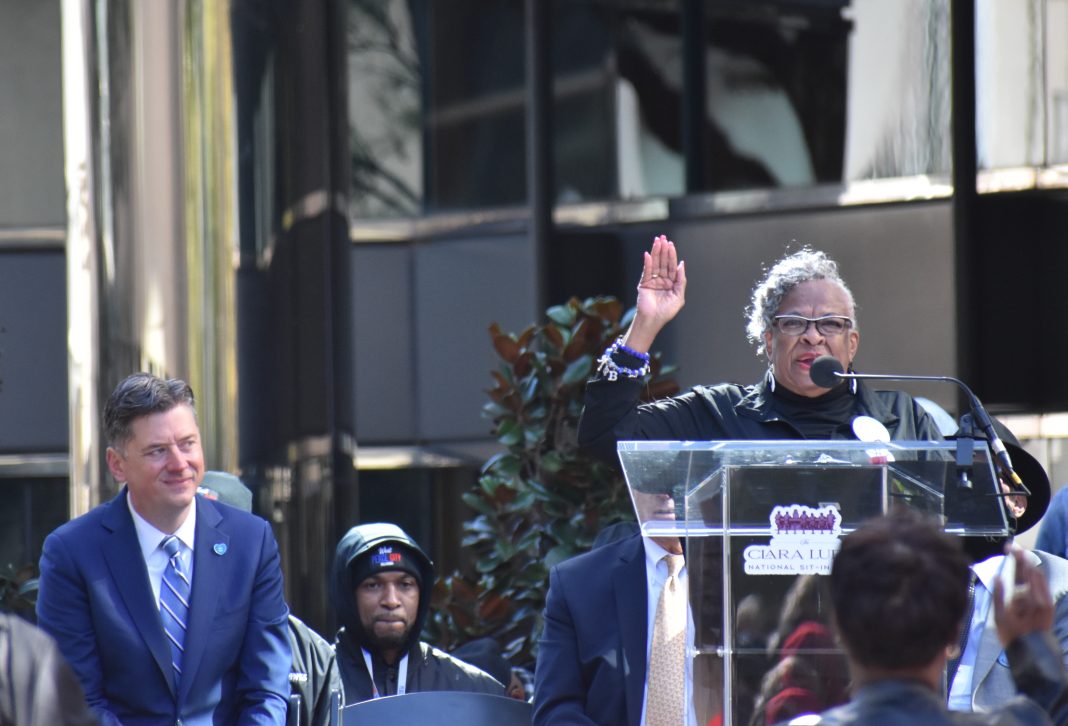OKLAHOMA CITY — The new Clara Luper National Sit-In Plaza in downtown Oklahoma City was crowded with hundreds of visitors on Saturday, Nov. 1, for the dedication of a bronze art installation memorializing Luper and the original 13 students who staged the nation’s first sit-in.
“The project represents a true community effort to honor the birthplace of the sit-in movement here in Oklahoma City,” said John Kennedy, project developer. “We are proud to recognize the courage and vision of the original 13 sit-inners and their teacher, Ms. Luper. May we never forget that we all have an opportunity to make a difference and that small actions can lead to big change.”
Marilyn Luper-Hildreth, daughter of Clara Luper and one of the original sit-in participants, told the crowd how the idea had formed.
Luper had written a play in 1957 titled “Brother President,” about the Rev. Dr. Martin Luther King, Jr., and the non-violent techniques that he used to eliminate segregation in Montgomery, Alabama. The play was seen by Herbert Wright, the National Youth Director of the NAACP, and he was so impressed that he invited Luper and the main cast of the play to New York City to perform for the “Salute to Young Freedom Fighters” rally.
While in New York, Luper’s students experienced eating in desegregated restaurants for the first time.
When they got back to Oklahoma City, the sting of segregation in their hometown motivated Luper and her students to come up with a plan: the sit-in, where they would simply sit at a segregated lunch counter until they were served.
The students and Luper waged the first sit-in at Katz Drug Store, right across the street from the place where the bronze installation now sits in downtown Oklahoma City, on Aug. 19, 1958. The sit-in was successful, and Katz desegregated its lunch counters.
Eighteen months later, a sit-in in Greensboro, North Carolina made national news, though few knew that the strategy had first been deployed in Oklahoma City.
Almost all of the original 13 students were present at Saturday’s dedication; two had passed away, as has Luper.
“Seeing it honored in bronze, with such care and collaboration, would have meant the world to my mother,” said Luper-Hildreth. “This sculpture ensures that future generations will remember that ordinary young people, acting together, can create extraordinary change.”
The four-ton sculpture is based on historical photographs showing the children seated at a lunch counter, as Luper, a waitress and others look on.
The event featured performances by the Langston University Concert Choir, the Dunjee All School Reunion Community Choir, and others. Poet Tinasha LaRaye performed her poem “13 Cokes and a Side of Freedom.” Joyce Henderson led the crowd in singing “Lift Every Voice and Sing” and “We Shall Overcome.”
“What happened here helped prove the concept. Yes, Clara and her kids changed Oklahoma City forever. But they also helped change the world,” said Mayor David Holt in his dedication remarks. The plaza “makes a statement about the kind of city that we want to be,” he said.





